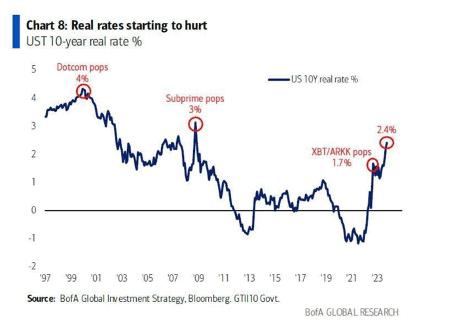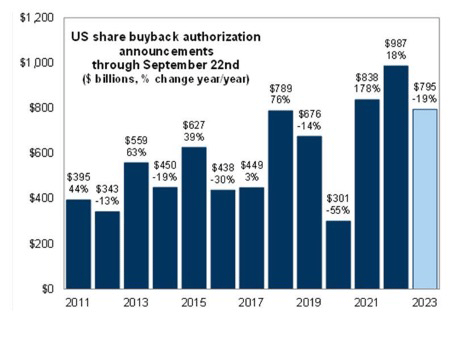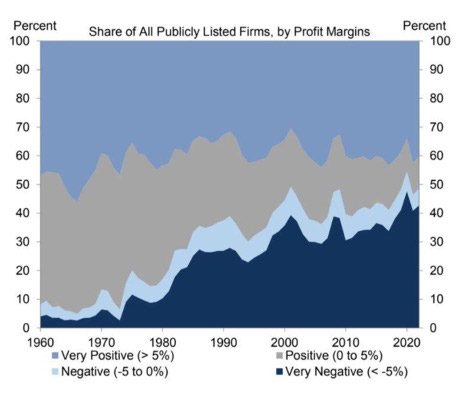

I'm tired.
My daughter had me in the pool for two hours today, and that giant fireball above took the wind out of me. In college, a few friends called me "Springtime Garrett" when I found myself in the sun for too long.
I do not tan well... I turn more of a lobster pink.
Combine that with whatever head cold or bug this little monster brought home from school that's impacted my sinuses... and we've got the Laziest of Sundays...

Still, we've got a full week ahead of us.
We kick off Monday futures in the Red - as markets continue to dissect the triple threat of higher energy prices, higher bond yields, and the prospect of war accelerating across the Middle East. Equity signals are all red on the index level.
As we noted yesterday, Fed Chair Jerome Powell highlights the monetary side of the market while earnings season hits its stride with a slew of bank and tech earnings to keep traders busy.
Today, I want to take a step back briefly and ponder three charts that caught my eye over the weekend.
Each one tells its own story of pitfalls and opportunities.
Let's keep it quick... There's a Buffalo Bills game to watch tonight (as I've effectively given up on this baseball season).
Chart 1: When the Levy Breaks
Everyone's waiting for the Fed to "break something" after the 525-basis point increase over the last 18 months. This term flows across various media sites and networks... as if they don't know what it means.
Yahoo! Finance ran this headline last month... which was curious.

News Flash! They already have.
- Emerging markets (EM) are getting crushed. EM stock market valuations are at the lowest levels compared to the S&P 500 in 36 years, according to Syz Group and Bloomberg.
- Regional banks imploded in March... forcing the Fed to bailout create 'new stabilization mechanisms for the financial sector,' and pretend that US Treasuries aren't the new weapons of financial mass destruction for the economy. There's more damage in store.
- This week, Bank of America will likely report that unrealized security losses are larger than the GDP of all but 62 global economies.
- We have the worst bond market since the 1700s (38-month bear market and counting).
- The United Kingdom's economy nearly collapsed last October while the Fed quietly altered its policies.
- And FTX would have gotten away with it, too... if it weren't for those meddling central bankers...
But something bigger is surely coming.
Why?
Because real rates - 'Interest Rates adjusted for inflation' - are rising.
We can look back at the Dot Com Bubble and the Subprime collapse for possible clues. We're certainly within striking range.

Surely, the Fed knows this... but I have a hard time believing our inflation numbers these days.
What would the Fed need to break before it chooses stability over inflation?
It'd have to be very big.
So what will it be?
- A massive bank run on Bank of America over unrealized losses?
- The collapse of a sizable private equity firm
- An insurance company blowing up with massive counterparty risk?
- Another major ally's economy crumbling?
Who knows... but our Equity Strength Signals will tell us when to get out of the way and when to wade back into the pool. We live in very interesting times.
Subscribed
Chart 2: Where's the Buybacks?
One great economic and political debate around corporate finance is the role of buybacks.
Progressives argue that companies will buy back stock to boost executive pay (as many executives are paid in stock and options). Others will argue that buybacks result from companies exhausting their expansion options and simply looking to boost shareholder value (where else will they put the money?).
Me?
I simply argue that incentives matter.
It's been estimated that we can attribute more than 10% of the S&P 500's last decade's performance solely to buybacks - with some estimates even higher.
When the Fed keeps interest rates at zero - and companies can borrow money from the market to buy back their stock - why wouldn't they?
But this chart from Goldman Sachs shows that buyback authorizations have fallen by 19% this year (through 9/22).

But get ready.
The next two months are typically very busy for corporate buybacks - and we could hear a lot of activity during this earnings season.
Chart Three: Will Rates Kill Zombies and the Market Too?
Now - as we've noted - interest rates won't impact companies until they don't have the ability to borrow anymore. So long as there is room on the balance sheet, profitability and rate levels haven't mattered for what feels like half my life.
If you want to see the impact of zero-interest rate policies over the last decade, have a look at this chart.

This visual represents all publicly listed companies and their profit margins.
Unprofitable companies - aka Zombie Stocks - are taking an increasing share of the market each decade.
The recent pop in the last few years can be partially attributed to the expansion of SPAC deals that captured the imagination of speculators.
We're not in a situation where nearly half of publicly listed companies are unprofitable.
With "higher for longer" as the mantra, we'll see who can borrow while we start the early innings of domestic credit contraction.
Oh... and let this be a warning - compliance costs are set to rise thanks to the SEC's plans around carbon emissions calculations. This will be the largest expansion of compliance since Sarbanes Oxley, which has contributed to a near-50% decline in public companies in 20 years.
Stay Positive,

Garrett Baldwin
Secretary of Defense


